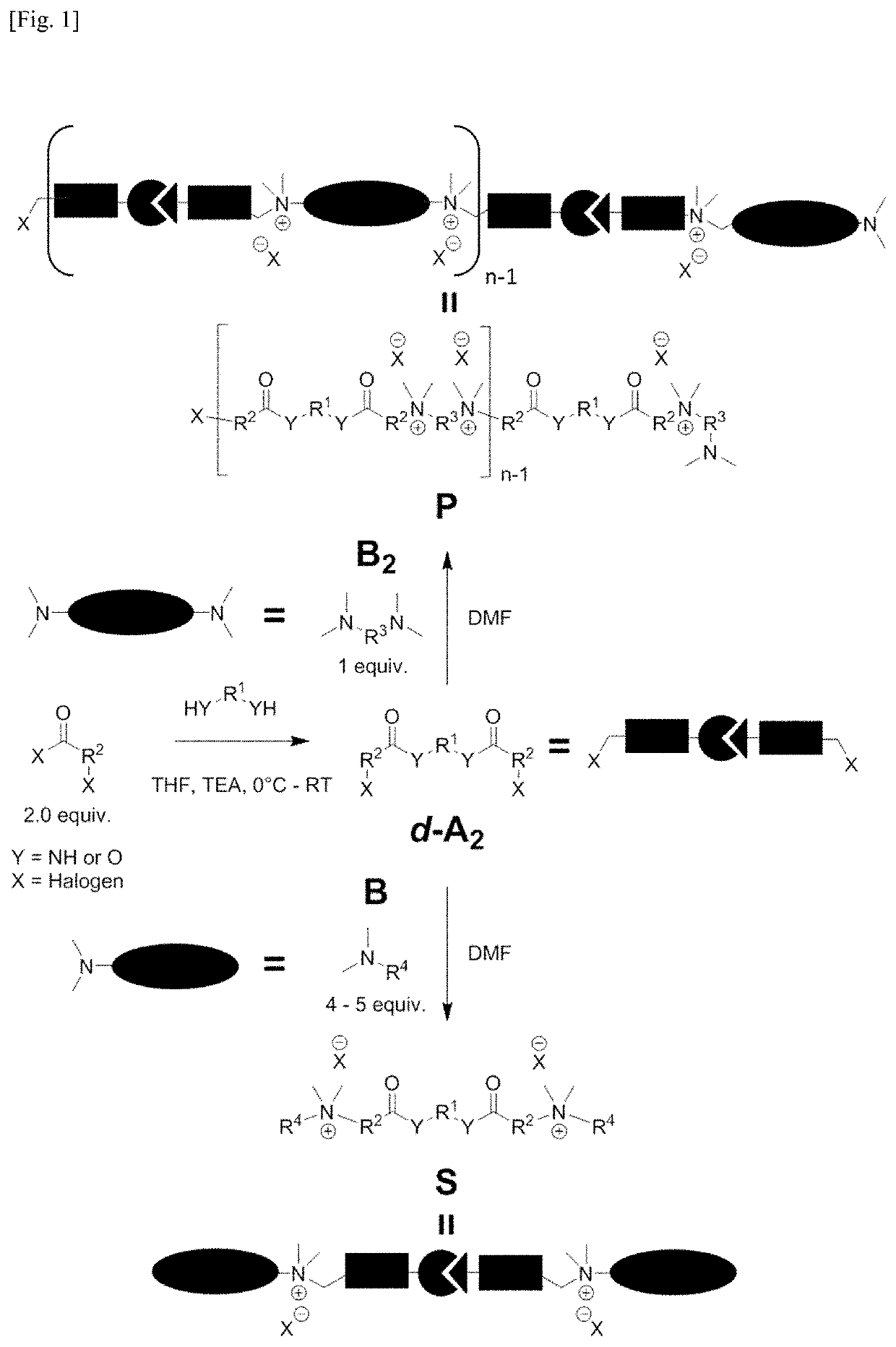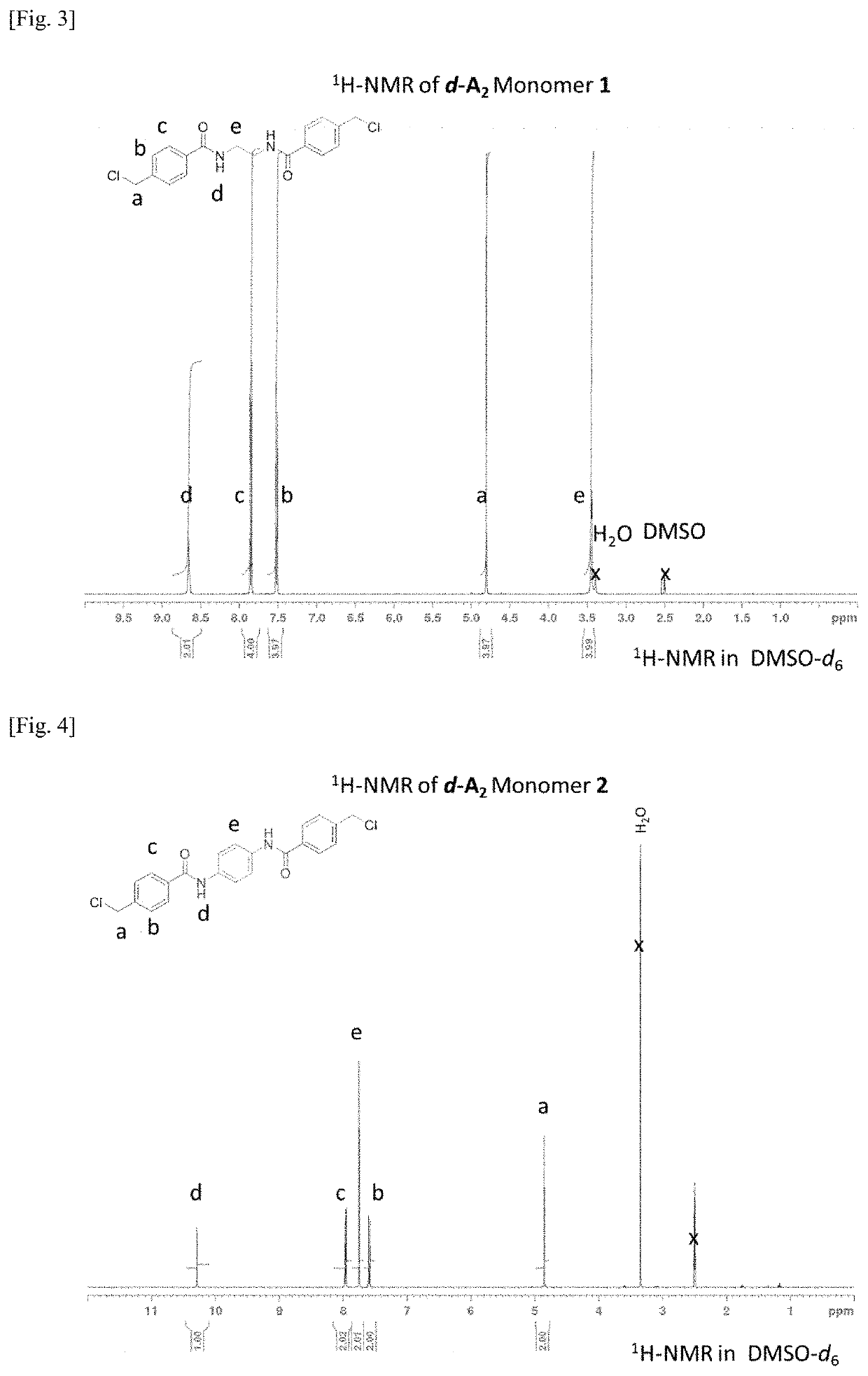Biodegradable polyionenes
a biodegradable, cationic polyion technology, applied in the field of new products, can solve the problems of biocompatible and environmentally-degradable antimicrobials, high toxicity, water-based organisms, etc., and achieve the effects of facilitating the degradation of compounds, facilitating time- and cost-effective synthesis, and tuning the degradability of polymers
- Summary
- Abstract
- Description
- Claims
- Application Information
AI Technical Summary
Benefits of technology
Problems solved by technology
Method used
Image
Examples
example 1
and Methods
[0421]Materials
[0422]All chemical reagents were purchased from Sigma-Aldrich (USA) or Tokyo Chemical Industry (Japan) and used as received unless specified. Mueller Hinton Broth (MHB) powder was purchased from BD Diagnostics (France) and used to prepare the microbial broths according to the manufacturer's instruction. Hydroxypropyl methyl cellulose (HPMC) H3785 and H7509, Igepal CO-520 and sodium dodecyl sulfate (SDS) were bought from Sigma-Aldrich. Igepal CA-630 was bought from MP Biochemicals Inc. (USA). N,N-bis(2-hydroxyethyl)dodecanamide (HDA) and N-decyl-b-D-glucopyranoside (DGP) were obtained from Flurochem. (UK). Cell lines of S. aureus (ATCC No. 6538), E. coli (ATCC No. 25922), P. aeruginosa (ATCC No. 9027), and C. albicans (ATCC No 10231) were obtained from ATCC, U.S.A., and reconstituted according to the suggested protocols. Rat red blood cells (rRBCs) were obtained from the Animal Handling Unit of Biomedical Research Centre, Singapore.
Methods
1H NMR Spectroscopy...
example 2
General Procedure for the Degradable d-A2 Monomer
Method A: Monomers Containing Aromatic Esters and Amides
Representative Example—Synthesis of N, N′-((ethane-1,2-diylbis(oxy)bis(ethane-2,1-diyl))bis(4-(chloromethyl) benzamide) (d-A2-4)
[0442]In a round two-necked bottom flask (500 mL) equipped with a magnetic stir bar and nitrogen inlet adaptor, 4-(chloromethyl)benzoyl chloride (10.55 g, 55.81 mmol, 2.0 equiv.) and tetrahydrofuran (THF, 20 mL) were allowed to equilibrate under ice-cold conditions for about 30 minutes. To this solution, a mixture of 2,2′-(ethane-1,2-diylbis(oxy))bis(ethan-1-amine) (4.14 g, 27.94 mmol, 1.0 equiv.) and triethylamine (12.0 mL, 8.7 g, 86.1 mmol, 3.1 equiv.), dissolved in THF (40 mL) were added dropwise via a dropping funnel over approximately 30 minutes. A white precipitate formed immediately. The reaction was allowed to proceed at room temperature for an additional 90 minutes. Deionized water (about 200 mL) was added to the reaction mixture to dissolve the...
example 3
n of the Synthesis of (Poly)Ionenes
[0464]Synthesis of d-A2 Monomers
[0465]It was found that (poly)ionenes with tunable degradability can be developed from functional monomers with built-in cleavable bonds. To achieve this, first a robust and facile method to produce a functional bis(halide), comprising a cleavable bond, was developed. Incorporation of an amide bond as the cleavable linker would result in the requisite stability for the compounds that would translate to meaningful shelf-life while at the same time, introducing potential biodegradability to the resultant (poly)ionenes.
[0466]A library of degradable bis(halide) A2-type monomers were synthesized by reacting two equivalence of chloromethyl benzoyl chloride with a diamine in the presence of a base, to result in d-A2 monomers 1 to 6, with good yields (FIG. 1 and FIG. 2). The selection of diamine would enable the tailoring of the hydrophobicity / hydrophilicity and / or the flexibility / rigidity, which are also determined by the s...
PUM
 Login to View More
Login to View More Abstract
Description
Claims
Application Information
 Login to View More
Login to View More - R&D
- Intellectual Property
- Life Sciences
- Materials
- Tech Scout
- Unparalleled Data Quality
- Higher Quality Content
- 60% Fewer Hallucinations
Browse by: Latest US Patents, China's latest patents, Technical Efficacy Thesaurus, Application Domain, Technology Topic, Popular Technical Reports.
© 2025 PatSnap. All rights reserved.Legal|Privacy policy|Modern Slavery Act Transparency Statement|Sitemap|About US| Contact US: help@patsnap.com



